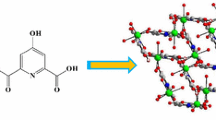Abstract
Lanthanide β-diketones and their derivatives are extensively studied coordination compounds, due to their luminescent properties and many possible applications. The tetrakisNd(III) complex with phosphorylated sulfonylamides derivatives of β-diketones was synthesized. The X-ray diffraction showed that the compound of formula {[Na[Ln(SP)4]} n (SP = C6H5S(O)2NP(O)(OCH3)2; Ln = Nd(III) crystallize in the monoclinic P21/c space group with the following unit-cell parameters: a = 22.006(4)A, b = 11.075(2)A, c = 22.334(5)A, and β = 118.71(3)°. The molecular structure of the investigated compound is polymeric. The lanthanide ions as well as the sodium ions are coordinated by sulfonyl and phosphoryl groups of the ligand, and because of the bridging behavior, link different units of the polymer. High-resolution absorption, emission, and excitation spectra of neodymium crystals were measured at 298, 77, and 4K temperatures. The sensitized emission of [Na[Nd(III)(L)4]} n chelate in the IR range of the spectrum was recorded. This kind of the compounds can be used in organic light emitting diodes in compact display technology. The spectral characteristic of the compound is controlled by donor–acceptor properties and electron-hole transporting chemical groups. Those factors affect the energy level location, energy transfer (ET), electron–phonon coupling, and finally the luminescence quantum yield. The optical behavior of the title compound was characterised by crystal field (CF), correlation crystal field (CCF), and electron transition probability calculations. X-ray structural data and the nephelauxetic effect check the role of the character of the bonding. The IR spectra were used to analyze the vibronic components in electronic transitions. The role of ligands, singlet and triplet states in energy transfer, are discussed. The ET mechanism and emission quenching pathways are proposed. Some spectroscopic parameters will be compared with earlier reported NaNdWo4 × H2O (Wo = CCl3 CONPO(OCH3)2).




Similar content being viewed by others
References
Legendziewicz J, Amirkhanov V, Jańczak C, Macalik L, Hanuza J (1995) J Appl Spectr (rus) 62:5
Oczko G, Legendziewicz J, Trush V, Amirkhanov V (2003) New J Chem 27:948
Binnemans K (2009) Chem Rev 109:4283
de Sa GF, Malta OL, Mello Donega C, Simas AM, Longo RL, Santa-Crus PA, da Silva EF Jr (2000) Coord Chem Rev 196:165
Riebrova ON, Biyushkin WN, Malinowski TI et al. (1982) Dokl A N USSR, 266:1391
Amirkhanov V, Ovchinnikov V, Legendziewicz J, Graczyk A, Hanuza J, Macalik L (1996) Acta Phys Polonica 90:455
Legendziewicz J (2000) J Alloys Compd 300–301:71 ibid. (2002) 341:34
Gawryszewska P, Sokolnicki J, Legendziewicz J (2005) Coord Chem Rev 249:2496
Legendziewicz J, Oczko G, Wiglusz R, Amirkhanov V (2001) J Alloys Compd 323–324:792
Amirkhanov V, Trush V, Kapshuk A, Skopenko V (1996) Zh Neorg Khim 41:2052
Hemmilä I, Laitala V (2005) J Fluoresc 15:529
Bünzli J-CG (2004) In: Sigel A, Sigel H (eds) Metals ions in biological systems, vol 42, Ch 2. Marcel Dekker Inc, New York
Hemmilä I, Mukkala V-M (2001) Crit Rev Clin Lab Sci 38:441
Faulkner S, Pope SJA, Burton-Pye PB (2005) Appl Spectr Rev 40(1):1
Faulkner S, Beeby A, Dickins RS, Parker D, Williams JAG (1999) J. Fluorescence 9:45
Shavaleev NM, Scopelliti R, Gumy F, Bünzli J-C G (2008) Eur J Inorg Chem 1523
Bünzli J-C G, Ihringer F (1996) Inorg Chim Acta 246:195
Hong Z, Liang C, Li R, Zhao D, Fau D, Wang D, Chu B, Zhang F, Hong LS, S-Te Lee (2001) Adv Mater 13:1241
Tsaryuk V, Zolin V, Legendziewicz J (1998) Spectrochim Acta A 54:2247
Tsaryuk V, Legendziewicz J, Zolin V, Sokolnicki J, Kudryashova V (2002) Proceedings of 11th international workshop on inorganic and organic electroluminescence, September 23, Ghent, Belgium, 2002
Kirsanov A, Shevchenko V (1954) Zh Obsh Khim 24:474
Kirsanov A (1952) Zh Obsh Khim 22:269
Scheidt WR, Turowska-Tyrk I (1994) Inorg Chem 33:1314
Sheldrick GM (1990) Acta Crystalologr Sect A 46:467
Sheldrick GM (1997) SHELXL-97 PC Version. University of Göttingen, Germany
Drew MGB (1977) Coord Chem Rev 24:179
Legendziewicz J, Bukietyńska K, Oczko G (1981) J Inorg Nucl Chem 43:2393
Legendziewicz J (1988) Wiadomości Chemiczne 42:605
Judd RB (1962) Phys Rev 127:750
Ofelt GSJ (1962) Chem Phys 37:511
Carnall WT, Fields PR, Rajnak K (1967) Chemistry division report
Carnall WT, Fields PR, Rajnak K (1967) J Chem Phys 49:4412
Mason SF, Stewart BS (1985) Mol Phys 385:611
Dallara JJ, Reid M, Richardson FS (1984) J Phys Chem 88:3587
Kirby AF, Richardson FS (1983) J Phys Chem 87:2557
Carnall WT, Goodman GL, Rajnak K, Rana RS (1989) J Chem Phys 90:3443
Wybourne BG (1965) Spectroscopic properties of rare earths (Interscience) New York
Reid MF (1987) J Chem Phys 87(5):2875
Judd BR (1977) J Chem Phys 66:3163
Rukmini E, Jayasankar C, Reid MF (1994) J Phys Condens Matter 6:5919
Sobczyk M, Solarz P, Lisiecki R, Ryba-Romanowski W (in preparation)
Li CL, Reid MF (1990) Phys Rev B 42:1903
Karbowiak M, Drożdżyński J, Sobczyk M (2002) J Chem Phys 117:2800
Sobczyk M, Karbowiak M, Drożdżyński J (2005) J Solid State Chem 178:536
Author information
Authors and Affiliations
Corresponding authors
Additional information
Dedicated to Professor Adam Bartecki on his 90th anniversary.
Electronic supplementary material
Below is the link to the electronic supplementary material.
Rights and permissions
About this article
Cite this article
Kulesza, D., Sobczyk, M., Legendziewicz, J. et al. Structure and spectroscopy of NaNd(SP)4 chelate: a new type of lanthanide luminophore. Struct Chem 21, 425–438 (2010). https://doi.org/10.1007/s11224-009-9548-3
Received:
Accepted:
Published:
Issue Date:
DOI: https://doi.org/10.1007/s11224-009-9548-3




